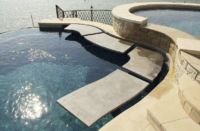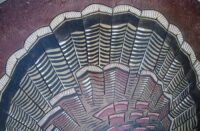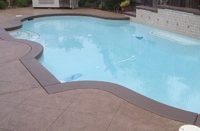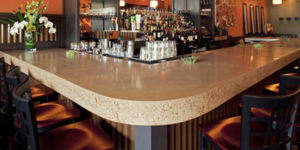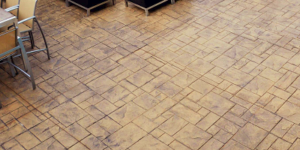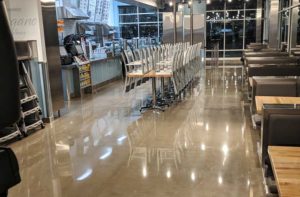
Spice 6, a fast-casual restaurant in Hyattsville, Md., serves up a zesty visual feast that complements its Chipotle-like “modern Indian” bill of fare.
A good deal of the credit goes to Hyde Concrete, an Annapolis, Md., concrete contractor specializing in decorative concrete and epoxy flooring.
Collaborating with Spice 6 owner Vic Singh and designer Claudia Humphrey, Hyde Concrete formulated and installed a stained and stenciled floor that won first place at the American Society of Concrete Contractors (ASCC) Decorative Concrete Council’s 2013 awards in the category of Graphics, Under 5,000 Square Feet.
Hyde owner Gregory Hyde Hryniewicz says Singh wanted something special — a design that combined a gold shimmer, an aged appearance, and a decorative pattern that reflected Asian influences.
In discussions with Singh and Humphrey, Hryniewicz presented ideas from existing samples and several mock-ups that he concedes were “pretty ugly” as a result of colors that didn’t work as hoped. “After a couple of tries, we asked to take a shot at something on our own,” Hryniewicz says. “And that’s how we came up with the final idea.”
Hyde Concrete collaborated with Modello Designs, a maker of decorative masking patterns, on stenciling for the floor of the central dining area. They used one of Modello’s Alhambra patterns, a design that suggests a bordered Oriental rug. The collaborators also devised a similar border pattern for three edges of the floor space.
The installation work began with filling a number of trenches in the existing concrete floor. Then, Hyde Concrete diamond-ground the concrete to produce a uniform surface, with two passes of 80-grit metal-bond diamonds.
Hyde Concrete outlined and traced the centerpiece pattern in preparation for application of the design’s background color. Three colors of H&C Concrete’s Semi-Transparent Decorative Stains were used to produce the hued effect. The colors — Cardinal Red, Pumpkin Spice and Dahlia Red — were applied to achieve a graduated effect, with an umber tone in the middle that increased in intensity toward a more crimson shade near the outer edges. Hryniewicz says the colors were bled over each other, with additional layers applied near the edges to amp up the color intensity.
 After an overnight dry of the stained area, the stencil of the centerpiece was put in place, a challenging process in that placing the pattern’s 14 panels required absolute precision, Hryniewicz says. He likened the procedure to affixing 2-by-4-foot stickers onto the surface, making certain of precise alignment without bubbles or wrinkles.
After an overnight dry of the stained area, the stencil of the centerpiece was put in place, a challenging process in that placing the pattern’s 14 panels required absolute precision, Hryniewicz says. He likened the procedure to affixing 2-by-4-foot stickers onto the surface, making certain of precise alignment without bubbles or wrinkles.
Pieces of the stencil were removed for selected areas to receive black acrylic paint. The black paint was spray-applied, with a gold paint used for highlighting to render a patina, or aged effect.
An identical process was followed to produce the stenciled border on the floor along three perimeter walls of the dining space. Flooring between the centerpiece pattern and the perimeter pattern was left uncolored.
Following removal of the stencil, inspection and minor touch-up, the entire dining-area floor was protected with application of a high-performance epoxy sealer — National Polymers Inc.’s NP015 water-based epoxy — followed by a protective topcoat of National Polymers’ NP344 high-solids polyaspartic aliphatic urethane clear coating. Hyde Concrete mixed an antiskid additive into the topcoat to enhance foot-traffic safety.
“The idea was to make the entire dining room area look as if an oversized rug was stenciled onto the concrete,” says designer Humphrey. A long booth-banquette that acts as the barrier for the queue line “appears as though a piece of furniture were set over the rug. The use of the border came around as an idea to treat the perimeter of the space that gets a lot of sun exposure through the storefront.”
 Hyde Concrete also precast two 6-foot-long concrete panels that hang from the wall below the service-line counter. The panels were formed in the shape of an upside-down J, from foam-core, lightweight GFRC.
Hyde Concrete also precast two 6-foot-long concrete panels that hang from the wall below the service-line counter. The panels were formed in the shape of an upside-down J, from foam-core, lightweight GFRC.
Humphrey, now a project designer with GTM Architects (Bethesda, Md.), but with Streetsense (also of Bethesda) at the time of the Spice 6 project, says the vertical concrete wrap at the service counter was part of a design concept to provide “tactile experiences” for customers in line.
“They first get to experience the wood finishing of the wall of the banquette, along with the glass that leaves the beautiful tile work on the tandoor oven in full view,” Humphrey says. “We thought it would be great to use a concrete countertop instead of a solid surface for the installation, and the idea of a wrap evolved as the shape of the counter started to take place. It was a great way to adjust the scale of the experience and highlight transitions between the tandoor oven and the final service area by using a really traditional material in a more unique way.
“We’ve done concrete countertops before, but nothing of this scale with a vertical component beyond the thickness of the countertop itself,” she says. “It was fantastic as soon as it was in, and it was the perfect complement to the ornate tile that’s on the back wall of the service line.”
Creative collaboration
Hryniewicz says the job demanded a collaborative design approach, creative thinking, technical proficiency and artistic expertise. And the sheer size of the decorative pattern added another dimension to the challenges.
“This is not what you would call typical,” he says. “Placing the stencils, all 14 of them, we had to be perfect in lining them up.” And the perimeter pattern had to line up on the three sides.
 There’s also artistry in producing the antiquing look and with the layering and metallic effects, he says. “There’s not a formula you can just follow. Application technique plays into how it’s all done. That’s where the applicator’s interpretation skill comes in.”
There’s also artistry in producing the antiquing look and with the layering and metallic effects, he says. “There’s not a formula you can just follow. Application technique plays into how it’s all done. That’s where the applicator’s interpretation skill comes in.”
Owner Vic Singh says he was looking for a “unique” design, something different from projects he had surveyed in an online search. He thinks Hyde Concrete delivered.
“I have not seen anything like the stencil work done with this,” he says.
“We looked at a few samples, and we had some different ideas about colors. The first try was not the color the way I wanted, so we changed colors and I think we found something with an Indian or South Asian-infused feel to it,” he says.
The floor colors contrast with, but complement, the vibrant blue of the restaurant’s walls, Singh says. He initially was leaning toward white for the walls but bought into Humphrey’s vision of a more striking color palette.
Humphrey calls Spice 6 “a great project, with a great client. He was really looking to take some traditional styles and ideas from India and make them a little more modern and accessible to the American palette.”
From the very beginning of the project, she and the owners discussed using stained concrete in the space because its new slab was in great shape, she says. “The warmth of the floor and the pattern provides a nice balance of tradition to the sleek, modern light fixtures.”
Besides its ASCC award, the modern look of Spice 6 received a vivid mention in a July 2012 restaurant review in the Washington Post. “The decor is poppy and fresh, but not overtly subcontinental,” observed writer Nevin Martell. “Though there are indigo walls, funky fixtures that mimic blossoming lotus flowers and henna-inspired scrollwork painted on the concrete floor, it could easily pass for a tapas joint or a frozen yogurt shop.”
Project at a Glance
Client: Spice 6 Restaurant, Vic Singh
Decorative concrete contractor: Hyde Concrete, Gregory Hyde Hryniewicz, owner | www.hydeconcrete.com
General contractor: Encore Construction Inc., Annapolis, Md. | www.encoreconstruction.net
Architect/designer: Claudia Humphrey, Streetsense, Bethesda, Md. | www.streetsense.com
Scope of project: Decorative staining, pattern stenciling, and precasting for a “modern Indian” fast-casual restaurant.
Most challenging aspect: Extensive discussion and evaluation of various color and design elements, precision alignment of stencil patterns, creative and artistic use of stain colors
Materials used: Modello stencils; H&C Concrete Semi-Transparent Decorative Stains in Pumpkin Spice, Cardinal Red and Dahlia Red; National Polymers Inc. NP015 water-based epoxy sealer and NP344 polyaspartic topcoat
